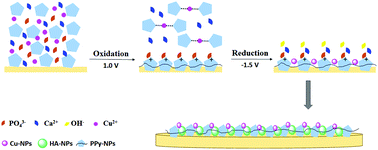Multifunctional HA/Cu nano-coatings on titanium using PPy coordination and doping via pulse electrochemical polymerization†
Abstract
The incorporation of hydroxyapatite nanoparticles onto the surface of titanium is an effective method to improve its osteoinductive ability. However, there are still issues with the hydroxyapatite nanoparticle coatings fabricated using current methods, such as particle aggregation and unsatisfactory binding ability with the matrix, in addition to the difficulties in the multi-functionalization of antibacterial, anti-wear and bioinductive ability. In the present study, we propose a strategy to fabricate a refined hydroxyapatite nanoparticles/copper nanoparticles co-deposition titanium matrix by the mediation of pulse electrochemical polymerized pyrrole through its coordination and doping of cations and anions. During this process, PO43− in the electrolyte is doped into the corresponding anion structure in the polypyrrole chain and forms HA with Ca2+ and OH− because of electrostatic interaction. The bioactivity investigation indicates that the composite coatings are able to induce the formation of apatite in supersaturated calcium phosphate solution. Furthermore, the friction and wear tests show that the composite coatings improve the friction properties of the material to a certain extent. The composites also exhibit an antibacterial rate of 97% in the antibacterial test. Finally, in virtue of the dual regulation of polypyrrole by coordination and doping, we successfully fabricate multifunctional hydroxyapatite/copper nano-coatings on titanium surfaces.



 Please wait while we load your content...
Please wait while we load your content...